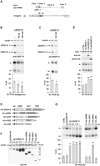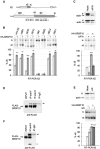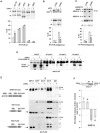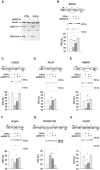SRSF10 Connects DNA Damage to the Alternative Splicing of Transcripts Encoding Apoptosis, Cell-Cycle Control, and DNA Repair Factors
- PMID: 27851963
- PMCID: PMC5483951
- DOI: 10.1016/j.celrep.2016.10.071
SRSF10 Connects DNA Damage to the Alternative Splicing of Transcripts Encoding Apoptosis, Cell-Cycle Control, and DNA Repair Factors
Abstract
RNA binding proteins and signaling components control the production of pro-death and pro-survival splice variants of Bcl-x. DNA damage promoted by oxaliplatin increases the level of pro-apoptotic Bcl-xS in an ATM/CHK2-dependent manner, but how this shift is enforced is not known. Here, we show that in normally growing cells, when the 5' splice site of Bcl-xS is largely repressed, SRSF10 partially relieves repression and interacts with repressor hnRNP K and stimulatory hnRNP F/H proteins. Oxaliplatin abrogates the interaction of SRSF10 with hnRNP F/H and decreases the association of SRSF10 and hnRNP K with the Bcl-x pre-mRNA. Dephosphorylation of SRSF10 is linked with these changes. A broader analysis reveals that DNA damage co-opts SRSF10 to control splicing decisions in transcripts encoding components involved in DNA repair, cell-cycle control, and apoptosis. DNA damage therefore alters the interactions between splicing regulators to elicit a splicing response that determines cell fate.
Keywords: DNA damage response; DNA repair; RNA binding proteins; SR proteins; alternative splicing; apoptosis; cell cycle; cell fate; hnRNP proteins; oxaliplatin; phosphorylation; splicing.
Copyright © 2016 The Authors. Published by Elsevier Inc. All rights reserved.
Figures






Similar articles
-
hnRNP A1/A2 and Sam68 collaborate with SRSF10 to control the alternative splicing response to oxaliplatin-mediated DNA damage.Sci Rep. 2018 Feb 2;8(1):2206. doi: 10.1038/s41598-018-20360-x. Sci Rep. 2018. PMID: 29396485 Free PMC article.
-
Modulation of the splicing regulatory function of SRSF10 by a novel compound that impairs HIV-1 replication.Nucleic Acids Res. 2017 Apr 20;45(7):4051-4067. doi: 10.1093/nar/gkw1223. Nucleic Acids Res. 2017. PMID: 27928057 Free PMC article.
-
SRSF10: an atypical splicing regulator with critical roles in stress response, organ development, and viral replication.RNA. 2021 Nov;27(11):1302-1317. doi: 10.1261/rna.078879.121. Epub 2021 Jul 27. RNA. 2021. PMID: 34315816 Free PMC article. Review.
-
E2F1 controls alternative splicing pattern of genes involved in apoptosis through upregulation of the splicing factor SC35.Cell Death Differ. 2008 Dec;15(12):1815-23. doi: 10.1038/cdd.2008.135. Epub 2008 Sep 19. Cell Death Differ. 2008. PMID: 18806759
-
Splicing factors of SR and hnRNP families as regulators of apoptosis in cancer.Cancer Lett. 2017 Jun 28;396:53-65. doi: 10.1016/j.canlet.2017.03.013. Epub 2017 Mar 14. Cancer Lett. 2017. PMID: 28315432 Review.
Cited by
-
Post-Transcriptional Regulation of Anti-Apoptotic BCL2 Family Members.Int J Mol Sci. 2018 Jan 20;19(1):308. doi: 10.3390/ijms19010308. Int J Mol Sci. 2018. PMID: 29361709 Free PMC article. Review.
-
Over-Expression of RNA Processing, Heat Shock, and DNA Repair Proteins in Breast Tumor Compared to Normal Tissue.Proteomics. 2020 Aug;20(15-16):e2000044. doi: 10.1002/pmic.202000044. Epub 2020 Jul 29. Proteomics. 2020. PMID: 32663359 Free PMC article.
-
N-Acetyl-l-cysteine restores reproductive defects caused by Ggt1 deletion in mice.Clin Transl Med. 2021 Aug;11(8):e510. doi: 10.1002/ctm2.510. Clin Transl Med. 2021. PMID: 34459136 Free PMC article. No abstract available.
-
Bcl-xL: A Focus on Melanoma Pathobiology.Int J Mol Sci. 2021 Mar 9;22(5):2777. doi: 10.3390/ijms22052777. Int J Mol Sci. 2021. PMID: 33803452 Free PMC article. Review.
-
Cytological Assessments and Transcriptome Profiling Demonstrate that Evodiamine Inhibits Growth and Induces Apoptosis in a Renal Carcinoma Cell Line.Sci Rep. 2017 Oct 3;7(1):12572. doi: 10.1038/s41598-017-12918-y. Sci Rep. 2017. PMID: 28974748 Free PMC article.
References
-
- Almeida LO, Garcia CB, Matos-Silva FA, Curti C, Leopoldino AM. Accumulated SET protein up-regulates and interacts with hnRNPK, increasing its binding to nucleic acids, the Bcl-xS repression, and cellular proliferation. Biochem Biophys Res Commun. 2014;445:196–202. - PubMed
MeSH terms
Substances
Grants and funding
LinkOut - more resources
Full Text Sources
Other Literature Sources
Molecular Biology Databases
Research Materials
Miscellaneous

